
|
|

April 3, 2005
WMCA 570 (and WNYC 820), Kearny, N.J.
By SCOTT FYBUSH
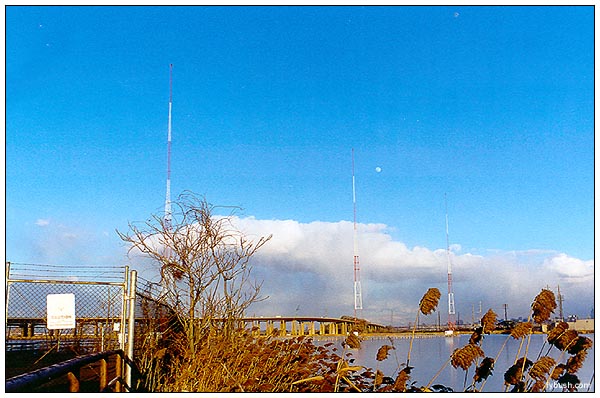 Despite
its relatively low power, WMCA has always enjoyed outsize stature
in the story of New York City radio. Perhaps it's the low dial
position (at 570 kHz, WMCA's 5 kilowatts get out almost as well
as the big guys' 50 kW rigs), or perhaps it's the high caliber
of programming that the station's provided over the decades -
whatever the case, it's hard to argue that WMCA is any less legendary
than many of its larger competitors.
Despite
its relatively low power, WMCA has always enjoyed outsize stature
in the story of New York City radio. Perhaps it's the low dial
position (at 570 kHz, WMCA's 5 kilowatts get out almost as well
as the big guys' 50 kW rigs), or perhaps it's the high caliber
of programming that the station's provided over the decades -
whatever the case, it's hard to argue that WMCA is any less legendary
than many of its larger competitors.
And as you'd expect, it has a transmitter site that's just as interesting, not to mention far more prominent than most. It's awfully hard, in fact, to miss the bright red neon of the "WMCA" sign glowing on the side of the transmitter building as you drive past it on the New Jersey Turnpike in Kearny, or the three self-supporting towers blinking in the swamp below the elevated Turnpike structure.
But for all the times your editor had driven by the place over the years, it wasn't until just this past February that the stars aligned for a look inside, in the company of engineer Tony DeNicola late one night after a Society of Broadcast Engineers meeting up the road at the WEPN site.
Before we go in, the history: WMCA's calls stand for the Hotel McAlpin, at Broadway and 34th Street, where the station began in 1925. It bounced around the dial a bit, landing on 570 in 1928 in what would prove to be an uncomfortable share-time arrangement with New York City's WNYC, which had the channel to itself until then. In 1932, WMCA effectively forced WNYC off 570, moving that station to 810 to take over the facilities of daytimer WPCH. WPCH, which had been co-owned with WMCA, shut down - and WMCA got 570 to itself, transmitting from a new facility in College Point, Queens.
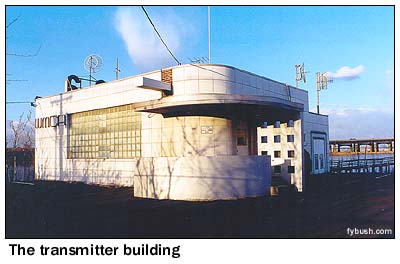 |
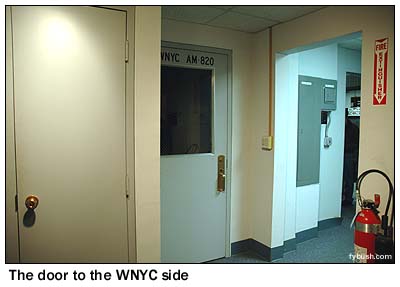 |
In 1940, WMCA moved to the other side of the market, building this facility on Belleville Turnpike in Kearny. (The location was chosen to allow maximum power over New York City - 5,000 watts - while still protecting co-channel stations on 570 in Youngstown, Dallas and elsewhere.) The three self-supporting towers, each 335 feet tall, are Truscon products; there are still vintage Truscon sales brochures in the files in the engineering office, as a matter of fact.
WMCA changed hands several times in the early 40s, being sold first to Ed Noble and then - after Noble had the chance to buy NBC's Blue Network and WJZ - to developer Nathan Straus, who would own it through its most prominent era. WMCA's programming was heavy on popular music long before most radio stations, and the station was also one of the pioneers of talk radio, with Barry Gray's late-night show debuting in 1950. By 1958, WMCA was playing top 40 music. It was an early home for Scott Muni and Herb Oscar Anderson, and its early-sixties lineup of "Good Guys" that included Harry Harrison, Dan Daniel, Gary Stevens, B. Mitchel Reed and Frankie Crocker was justly legendary, giving WABC a run for its money all through the sixties.
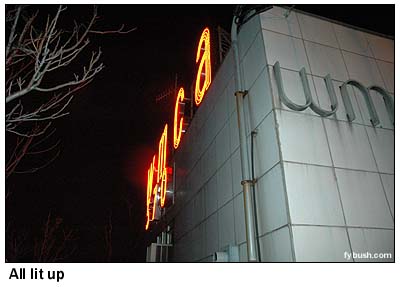 |
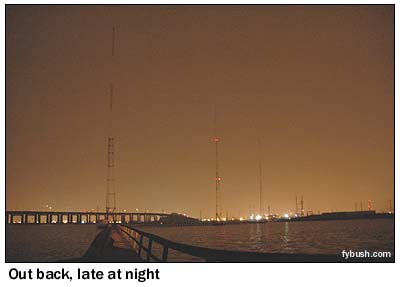 |
In 1969, WMCA again got ahead of the curve by programming talk for most of the day, and by 1970 it was all-talk, giving Long John Nebel, Alex Bennett, Barry Farber and Bob Grant a home in the market.
The rise of FM, the growth of talk radio on bigger signals (most notably WABC's switch from music to talk in 1982) and the sprawl of the market beyond the reach of WMCA's directional 5 kW signal gradually sent the station into something of a decline, and by 1987 the Straus family had sold the station. WMCA changed hands once more in 1988, becoming the New York flagship for Salem Communications, which sold WNYM (1330) to get the more potent signal at 570. Ever since then, WMCA has been a religious station - but not without a nod to its heritage, as vintage WMCA "Good Guys" jingles still play during breaks in the programming.
One more bit of irony: in 1989, the Kearny site became home to a second station - and it was none other than WNYC, the station WMCA had ousted from 570 all those years ago. WNYC moved from 830 kHz and 1000 watts, daytime only, to 820 kHz and 10 kW/1 kW from the Kearny towers, taking over what had been a studio space at the front of the building for its transmitter. (WNYC and WMCA would later explore the possibility of increasing power and building three more towers at Kearney, but the upgrades were never built and WMCA's CP for 50 kW day/30 kW night eventually expired, unbuilt.)
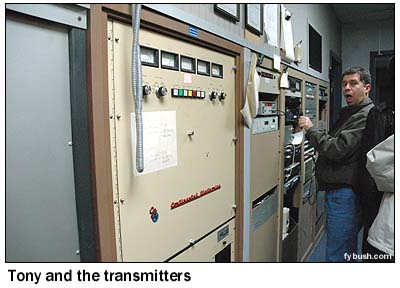 |
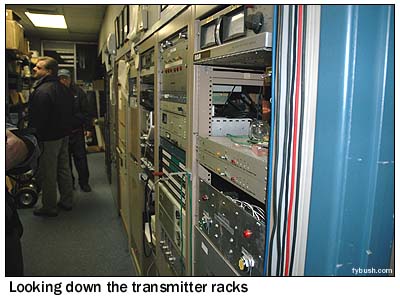 |
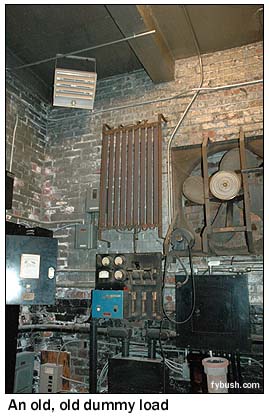 So in
we go: through the Art Deco entrance, past the locked door to
WNYC's room, and around the corner to the row of transmitters
and gear that faces shelves full of "retired" equipment.
The main transmitter is a Nautel, mostly out of frame in the
photo at left, with a Continental 316-series backup right next
to it, plus lots of STL gear, remote controls, a nifty homebrew
antenna/transmitter switcher, and so on.
So in
we go: through the Art Deco entrance, past the locked door to
WNYC's room, and around the corner to the row of transmitters
and gear that faces shelves full of "retired" equipment.
The main transmitter is a Nautel, mostly out of frame in the
photo at left, with a Continental 316-series backup right next
to it, plus lots of STL gear, remote controls, a nifty homebrew
antenna/transmitter switcher, and so on.
Around the corner and behind the transmitter, there's a rack full of emergency equipment (a rudimentary board, cassette decks, reel-to-reel decks and cart machines) that could be pressed into service if the station ever needed to broadcast from Kearny, and all the way in back is a room that houses electrical panels, a generator - and that 1940-vintage dummy load up there on the wall! (Check out the knife switch below it, too...)
The engineering office still contains some of the original conductivity surveys and other work done to get this site licensed way back in 1939-1940 - and it's a treasure trove of history in other ways, too, including correspondence between WMCA management and the Turnpike Authority asking workers building the road to stop climbing the WMCA towers to do their surveying!
And up on the wall is a truly remarkable bit of history: an aerial photo, probably taken in the fifties or early sixties, showing WMCA and its then-neighbors on Belleville Turnpike.
Long before WMCA arrived, this area was already a popular spot for New York's AM stations. WOR came to Kearny in 1927, operating from a transmitter plant on Communipaw Avenue (today's Routes 1 & 9), just north and east of what would become the WMCA site. WLWL arrived on Belleville Turnpike in the early thirties, and its site just west of WMCA's remained in place even as the station evolved into WOV (1940) and then WNEW (1941). It's not obvious from the aerial photo, but the two WNEW towers had big, distinctive capacitance hats atop them, a real landmark for drivers.
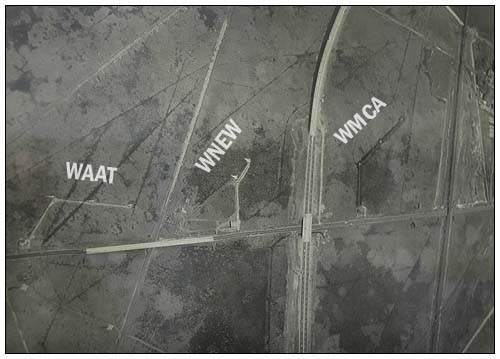 The
last station to call this one-mile stretch of Belleville Turnpike
home was WAAT (970), which changed its city of license from Jersey
City to Newark in 1941 and built a three-tower array just west
of WNEW. (WAAT would later change calls to WJRZ.)
The
last station to call this one-mile stretch of Belleville Turnpike
home was WAAT (970), which changed its city of license from Jersey
City to Newark in 1941 and built a three-tower array just west
of WNEW. (WAAT would later change calls to WJRZ.)
The construction of the west spur of the Turnpike in the late sixties forced WJRZ and WNEW to move. The WJRZ site was leveled when the station left in 1968 (it would soon become WWDJ at its new home in Hackensack; ironically, it's now WMCA's sister station under Salem ownership), but the WNEW site would live on as a ghost after that station moved to its new home a few miles north in Carlstadt. The old WNEW building still stands, vacant, on Belleville Turnpike - and the two towers were simply toppled into the shallow water where they stood. (What looks like dry land in the aerial image to the right was later flooded, and the WMCA towers now stand in a few feet of brackish water. That's the main Turnpike between WMCA and WNEW; the west spur now cuts across Belleville Turnpike right about where the WAAT building was.)
The "top hats" of the WNEW towers were wide enough that they weren't submerged when the towers went down. To this day, their edges still stick up above the water. (They can even be seen in the opening credits of The Sopranos, in a very brief shot off the side of the Turnpike just after shots of a church and a train.)
And with that, we leave our late-night tour of one of New York's more unusual AM sites. We'll be taking a week off to collect many more images and stories around New England - and to visit the commemoration of the 70th anniversary of Major Armstrong's first FM broadcasts. So join us next week for an encore look at Armstrong's Alpine, N.J. tower - and we'll be back with fresh sticks June 17!
It's here - the 2005 Tower Site Calendar is now available at special clearance prices! Click here for ordering information!
- Previous Site of the Week: 77 WABC, Lodi, N.J.
- Next Week: The Armstrong Tower, Alpine N.J.
- Site of the Week INDEX!
- How can you help support Site of the Week? Click here!
- Submit your suggestions for a future Site of the Week!
